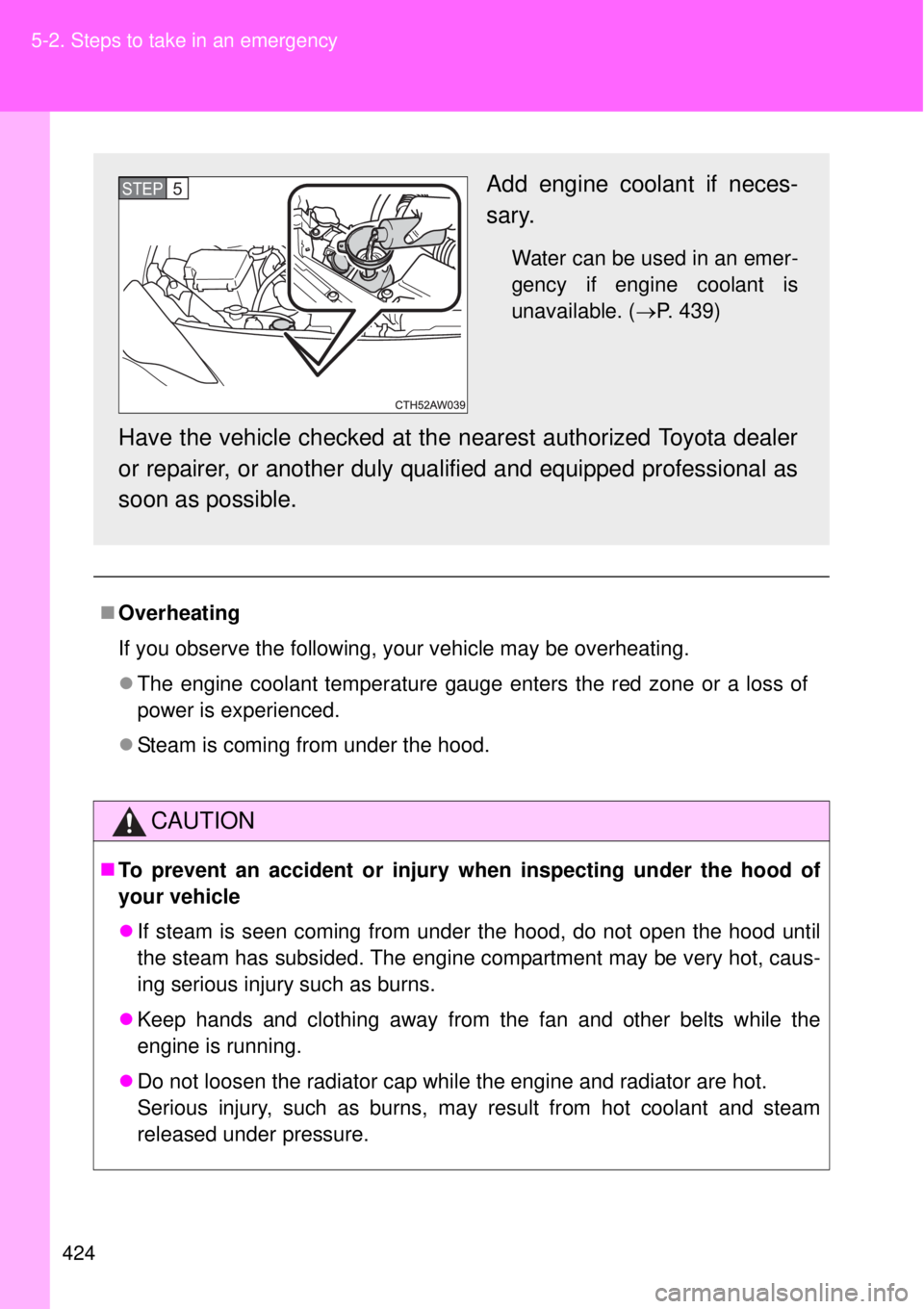Page 423 of 464
5
423
5-2. Steps to take in an emergency
When trouble arises
If your vehicle overheats
If your engine overheats:
Stop the vehicle in a safe place and turn off the air condi-
tioning system.
Check to see if steam is coming out from under the hood.
If you see steam:
Stop the engine. Carefully lift the hood after the steam sub-
sides and then restart the engine.
If you do not see steam:
Leave the engine running and carefully lift the hood.
Check to see if the cooling fan is operating.
If the fan is operating:
Wait until the temperature of the engine (shown on the
instrument cluster) begins to fall and then stop the engine.
If the fan is not operating:
Stop the engine and call any authorized Toyota dealer or
repairer, or another duly qualified and equipped profes-
sional.
After the engine has cooled
down sufficiently, check the
engine coolant level and
inspect the radiator core (radi-
ator) for any leaks.STEP 1
STEP 2
STEP 3
STEP 4
Page 424 of 464

424 5-2. Steps to take in an emergency
Overheating
If you observe the following, your vehicle may be overheating.
The engine coolant temperature gauge enters the red zone or a loss of
power is experienced.
Steam is coming from under the hood.
CAUTION
To prevent an accident or injury when inspecting under the hood of
your vehicle
If steam is seen coming from under the hood, do not open the hood until
the steam has subsided. The engine compartment may be very hot, caus-
ing serious injury such as burns.
Keep hands and clothing away from the fan and other belts while the
engine is running.
Do not loosen the radiator cap while the engine and radiator are hot.
Serious injury, such as burns, may result from hot coolant and steam
released under pressure.
Add engine coolant if neces-
sary.
Water can be used in an emer-
gency if engine coolant is
unavailable. (P. 439)
Have the vehicle checked at the nearest authorized Toyota dealer
or repairer, or another duly qualified and equipped professional as
soon as possible.
STEP 5
Page 425 of 464
5
425 5-2. Steps to take in an emergency
When trouble arises
NOTICE
When adding engine coolant
Wait until the engine has cooled down before adding engine coolant.
When adding coolant, do so slowly. Adding cool coolant to a hot engine too
quickly can cause damage to the engine.
Page 439 of 464
439 6-1. Specifications
6
Vehicle specifications
Cooling system
Ignition system
CapacityVehicles with an automatic transmission
7.5 L (7.9 qt., 6.6 Imp. qt.)
Vehicles with a manual transmission
7.2 L (7.6 qt., 6.3 Imp. qt.)
Coolant typeUse either of the following.
• “TOYOTA Genuine 50/50 Pre-mixed Super Long
Life Coolant BLUE”
• Similar high-quality ethylene glycol-based non-
silicate, non-amine, non-nitrite, and non-borate
coolant with long-life hybrid organic acid technol-
ogy
Do not use plain water alone.
Spark plug
Make
GapDENSO ZXE27HBR8
0.8 mm (0.031 in.)
NOTICE
Iridium-tipped spark plugs
Use only iridium-tipped spark plugs. Do not adjust gap when tuning engine.
Page 454 of 464

454 Alphabetical index
Electric power steering ........... 225
Electronic key
If the electronic key does
not operate properly ........... 414
Emergency flashers
Switch ................................... 362
Emergency, in case of
If the electronic key does
not operate properly ........... 414
If the engine will not start ...... 409
If the shift lever cannot
be shifted from P ................ 412
If the vehicle has a
discharged battery .............. 418
If the warning buzzer
sounds ................................ 372
If the warning light
turns on............................... 372
If you have a flat tire ..... 384, 393
If you lose your keys ............. 413
If you think something is
wrong .................................. 370
If your vehicle becomes
stuck ................................... 426
If your vehicle has to be
stopped in an
emergency .......................... 428
If your vehicle needs to
be towed ............................. 363
If your vehicle overheats ....... 423Engine
Compartment ........................ 301
Engine switch................ 169, 178
Hood ..................................... 297
How to start the
engine......................... 169, 178
Identification number ............ 433
If the engine will not start ...... 409
Ignition switch ............... 169, 178
Overheating .......................... 423
Engine coolant
Capacity ................................ 439
Checking ............................... 305
Engine coolant temperature
gauge...................................... 194
Engine immobilizer system ...... 91
Engine oil
Capacity ................................ 436
Checking ............................... 302
Preparing and checking
before winter....................... 233
Engine switch .................. 169, 178
Engine switch light .................. 259
EPS ........................................... 225
Event data recorder ................... 24E
Page 462 of 464
462
What to do if...
What to do if...
A tire puncturesP. 3 8 4
P. 3 9 3If you have a flat tire
The engine does not start
P. 4 0 9If the engine will not start
P. 9 1Engine immobilizer system
P. 4 1 8If the battery is discharged
The shift lever cannot be
moved outP. 4 1 2If the shift lever cannot be shifted
from P
The engine coolant temperature
gauge enters the red zone
Steam can be seen coming
from under the hood
P. 4 2 3If your vehicle overheats
The key is lostP. 4 1 3If you lose your keys
The battery runs outP. 4 1 8If the battery is discharged
The doors cannot be lockedP. 5 5Doors
The vehicle is stuck in mud
or sandP. 4 2 6If the vehicle becomes stuck
A warning light or indicator
light comes onP. 3 7 2If a warning light turns on or a
warning buzzer sounds...